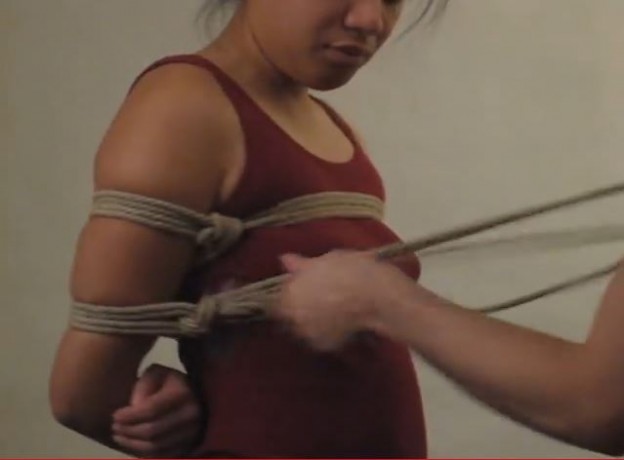It’s been quite a week on the forums! I have been banned from yet another group for daring to speak of ‘the tie that shall not be named’ (aka 3T-SNBN) or as, I prefer that ‘Japanese Box-Tie Thingy’ (JB-TT). My crime was to suggest that firstly there was no such thing as “The TK” and secondly that many ties that do not fulfil the required function are cited as such in incidents reports leading to an undeserved reputation as a dangerous tie. Apparently, posting such a suggestion was so heretical and elitist in the view of some of the moderators of Fetlife’s REF (Rope Educators Forum) that I was banned and my threads removed! I say “threads” as after the first was hijacked with cries of elitism of over using “The TK” as my example. I merely cite it because it seems the most common example and the name on everyone’s lips. This precipitated a week of lively debate in my Kinbaku Group in several threads and over 300 posts. Ironically, the end result was an own goal for REF as several very knowledgeable members left in disgust and my membership swelled considerably.

No,I don’t fly like a duck
My position is that “The TK” is an entire family of ties. Indeed, there is some debate whether TK, takate kote, refers only to ties meeting its literal description of ‘high hands behind’ and should not include parallel arms versions. I suspect this could be a regional difference or even personal preference in Japan but it’s not important for this discussion. If I use a Japanese word at all these days, I prefer the more all-encompassing term ‘gote’. Let’s just agree that for most westerners it means a box-tie of Japanese origin. For many, it means something that just looks like one. It certainly gets used as if it were only one tie and to covers almost anything with two sets of torso wraps encompassing arms and wrists tied. Herein lies the problem, looking like something doesn’t make it behave the same. A platypus swims, has webbed-feet and a bill like a duck but it doesn’t make it fly like a duck. Neither does it mean ducks have venomous spines. Many so-called TK’s don’t fly like one either so this functional failure might be the problem, not the tie.
One only has to search Google Images to see the wide interpretation of the term “takate kote”: Search results. I hope that even the relatively untrained eye will see that these examples exhibit typical errors, e.g. poor wrap placement likely to cause nerve damage. In fact some are so bad, I’d be hard pushed to place wraps any worse if I was actually trying to cause nerve damage! I shudder to think of the results should an inexperienced rigger use some of these photos as their reference. The thrust of my REF posts was that we need to help students get it right and one suggestion was better aide memoires. During a workshop, one might think one has all 60-odd steps off pat but a few days later during practice, mistakes can creep in and, before you know it, be committed to muscle memory. Self-critique, creativity and a better understanding can be achieved if the function is also explained. Not just “Do this!” but why you do it. This does pre-suppose the teacher giving the workshop knows all this in the first place and allocates sufficient time.
Here the two sides seemed to polarise. One side believed that this type of tie was inherently dangerous since it encompassed the arms thus creating an inevitable risk of nerve damage. Interestingly, everyone seemed to forget that JB-TT’s are merely formalised and well-tested box-ties. Maybe this is not surprising as they seemed to champion chest harnesses that often didn’t even restrict the wrists. Judging by the profile pictures of most of this group, I saw little evidence of the ability to tie any type of box-tie which incorporated the best practices and function of the formal forms taught by the Japanese masters that I have encountered. I felt it indicative of the level of understanding of this deceptively complex tie when I saw one ‘educator’ offering a basic 2-hour shibari class covering takate kote as one of no less than six other ties! In contrast, workshops by Japanese masters dedicate a full day or two at least to a single gote which I’d say that give one a basic understanding. Then, it takes practice to master.
The other school of thought maintained, as I do, that a properly tied JB-TT is pretty safe if tied properly but a liability in unskilled hands. I always draw the parallel of a fast motorcycle. Very few are inherently unsafe but all require some skill, care and training to minimise risk. Bikes will always be more dangerous than cars but the roads will never be safe, not even if we all take to tanks 🙂 The risk is in the hands of unskilled users all things being equal .
All I can say is that a lot of professional rope models pass through this house and several I know very well. Injuries seems very rare. If this tie were inherently dangerous they’d be crippled since they perform it almost daily. Why to they remain safe? My guess is they are tied by people who are experts in applying this type of tie. They will give feedback if something isn’t right. One should not ignore that they are at the top of their game and pushing the envelope. They know their bodies in rope very well, are young, relatively fit and not overly susceptible to nerve injury. Accidents happen when confidence exceeds ability, either in terms of skill or physical capability.This is well know as a tendency with new drivers, especially motorcyclists. Accident rates decline rapidly once experience tames rashness. Sadly, it usually takes one or two expensive and painful close encounters with the tarmac to learn this lesson. It has been suggested if the consequences in rigging were a little more personal like this we might take more care but we’ll never know.
In my experience, those that hold the opinion that the problem is not the tie tend to be much more purist and Japanese in their style. Most had either attended workshops with acknowledged Japanese master or had attended high level tuition on multiple occasions. Not only have they tied many 100’s, if not 1,000’s, of gote but some can faithfully reproduce several versions by different sensei and even know the variations within those.
Looking at my own perception of my knowledge over my career, I would say kinbaku is a subject that is like an iceberg. Only 10% is clearly visible. Pretty patterns with jute rope. Once one starts learning, it becomes obvious that is has multiple layers like an onion. I have had several periods in my life where I have naively thought I had begun to know something about this art, only to discover a whole new layer. In short, sometimes you don’t know what you don’t know. It takes a little learning to appreciate the depth contained in this deceptively simple tie. Not only that, one realises that the whole raison d’etre is different from western bondage. This is embodied in ubiquitous quotes like “the rope is an extension of your hands” and “the rope is a tool of communication”.
Many know how Osada Steve and I met but the story might serve as a moral tale for others. Many, many years ago, some bloke emailed me telling me I was talking bullshit on-line about shibari. WTF?! Who was this guy? I’d read Mindori’s book so I was an expert! I remained convinced that he was making a big mystique out of nothing just to flog expensive lessons. Roll forward to seeing Japanese bondage as done in Japan and finding out ‘this bloke’ was Osada Steve who knew a thing or two about this shibari stuff…we kissed, made up, I eventually persuaded him to teach me, the rest is history…I bet I could still spend all week with him and learn things about tying JB-TT’s or whatever we have to call them.
This family of ties covers a wide range designed for different purposes. The right engineering is important to achieve the function safely. For example, a typical Yukimura gote is not designed for dynamic suspensions like some of the technical Kanna style 3-rope gote. For the most part, the function of a JB-TT is to keep the bindings in place safely and away from vulnerable nerves and , during suspension, to provide support. This applies whether your box-tie originates from the west, Japan or a far flung galaxy and regardless of what you call it. Obviously, one needs to consider the whole process when trying to optimise safety as the tie cannot be taken in isolation. The person tied, their individual differences and the type of bondage planned are all factors to be considered since it is an holistic exercise. Here, I’m concentrating on aspect of the tie, so we can leave the other factors out of this discussion.
Since safety is the only consideration, we can also ignore any nit-picking over exact authenticity of style as long as function is fulfilled. This really isn’t about elitism or being pedantic. I suspect those who bleat about that do so as a smoke-screen for the lack of ability to discuss or analyse the tie meaningfully. Condemnation is easier than discussion. So, whilst an Osada ryu TK might be judged technically wrong with an X-friction on the lower wraps, it is irrelevant, apart from semantically, if that friction does the job. The problem lies when, for example, the correct friction is not compacted so does not fulfil its function and it results in a failure leading to injury. In such cases, it is easier to blame the tie than oneself but the workman should not blame his tools. One might make a fundamental error unknowingly if one has been given the impression that a few minutes demonstration at a rope convention constitutes adequate training. I’m really not sure whether those who perpetuate such myths do so out of ignorance, ego or self-interest. I have noticed a tendency for some individuals to censor posts or ban members who might in some way challenge their knowledge. Whether the fact that some are prolific educators has any bearing, I will let you decide. However, I think a glance at the evidence in the profiles of the participators in related threads will allow one to make some evaluation of the credentials and motivation of those involved 😉
On a positive side, we have proved it is possible to hold contentious discussions with the censorship of bannings, post deletions or closure. Sure, things get heated but the sky doesn’t fall in and I doubt any of the participants are traumatised. I’m proud to say that we now have over 1,700 members with no bannings or thread closures and have only deleted a couple of posts at the request of the OP. Long live my little corner of anarchy and screw the petty Hitlers!
As I rope supplier, my hands-off moderation style is based upon giving enough rope to those who wish to publicly hang themselves for our entertainment. A good public hanging never losses its appeal as 298 posts on just that thread and record numbers perving shows, never mind the other threads it spawned 😀 As for me, I have nothing to fear since I freely admit I am human, admit mistakes, don’t know everything and appreciate that my anus in not the source of solar radiation (more an energy saving bulb among a firmament of stars, if anything). I guess my vice is being ‘rigger in the woodpile’ and saying what others think better of saying. Foot in Mouth Disease is a genuine affliction, it’s not my fault 🙂 Blame the Simon Cowell Charm School master-class. I think it’s time to get my gote…
Anyway, I heard a nice quote upon which I will leave you to meditate “Do not follow the masters, follow what the masters seek”.
UPDATE
This exchange between topologist and I will amuse, and possibly sadden, you. You can see my quotation “Bikes will always be more dangerous than cars” in this very article. I think this says a lot about the mind-set and level of knowledge of the “TK’s are inherently dangerous” faction. They will always believe what they wish to regardless of facts. Sadly, they some seem unaware of many of the key facts in the first place.

Whilst he apparently designed the much-acclaimed Somerville Bowline, it seems our friend. topologist. is out of his depth and more than a little hazy on the anatomical risks of box-ties. I quote from his web site:
“Because the radial nerve wraps around the upper arm in the general area where these bands of rope are positioned, when TKs are used for suspension and body-weight-scale forces are placed on the ropes around the arms, there is a risk of the radial nerve being compressed.”
Whilst clearly the radial is vulnerable in the upper arm, this area is on the inner side where the upper cinch can sometimes catch it. The vulnerability on the outside where rope might compress it is typically found around/below the top of the lower third of the upper arm.
It appears that he has chosen to base his expertise on a small and somewhat technically dubious survey, as opposed to established medical knowledge and peer reviewed research. Nevertheless, topologist condemns “The TK”. Furthermore, he feels he has the expertise to design what he is championing as an improvement, the chest-loading TK. Whilst it might reduce loading on the arms, there is still rope being placed in vulnerable areas, e.g. upper cinch, lower wrap. As we know, the upper cinch can be problematic with some people. It is my suspicion is that most upper cinch injuries are during side suspension to the arm nearest the ground, when rope is sandwiched between arm and rib cage and pressed into the radial by the body weight.
Here’s a grab from one of his YouTube videos. I’ll let you decide how good the wrap positioning is here, assuming a typical nerve path for the radial, and upon other matters like compacting frictions. If you are happy with everything, I suggest reading my articles on tying this type of tie if you don’t want to cause injuries;-)
Until. education is improved and people realise that it takes some skill and dedication to tie a JB-BT with a good degree safety, accident rates will be be unacceptably high. Workmen will unfairly blame their tools. I doubt they would go rock climbing or ride a high-powered motor bike after seeing a couple of YouTube videos of dubious value or attending a short workshop. If they did, you call them idiots and would be unsurprised if they came to serious harm. I fail to follow the logic that makes suspension bondage using a JB-BT the exception. Quite simply, it is no different; it also requires a high degree of knowledge and skill.


